The IC LM386 is a 8-pin tiny power amplifier chip, specially made for operating under relatively low voltage parameters, yet provide considerable amplification.
IC LM386 amplifier circuit becomes suitable for applying in small low power audio gadgets like in FM radios, door bells, telephones etc.
Let's begin the IC LM386 amplifier explanation by studying its absolute maximum ratings first, meaning the parameters which should not be exceeded while using this IC in any circuit:
Technical Specifications of IC LM386
- Supply Voltage: 4V to Max. 15V (Typical)
- Input Voltage: +/- 0.4 volts
- Storage Temperature: -65 degrees to +150degrees Celsius
- Operating Temperature: 0 to 70 degrees Celsius
- Power Output: 1.25 watts
- IC manufactured by: National Semiconductor
Internal Schematic
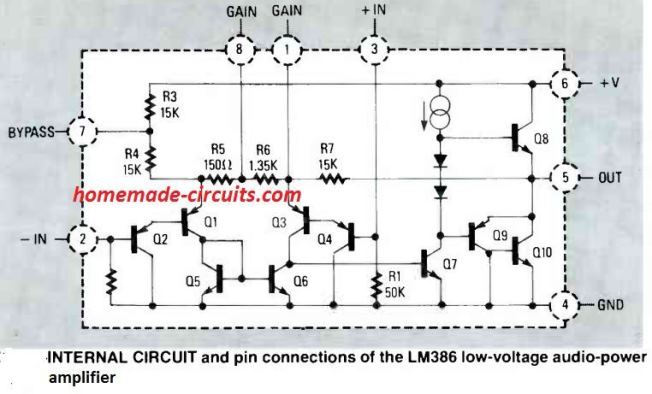
How to Control Gain for the IC LM386
In order to make the IC better with its response, its pin#1 and 8 have been attributed with a gain control facility which may be set externally.
Gain simply means the capacity or the amplifying level of the device up to which it is able to amplify the applied input low signal audio input.
When the above pin outs are kept unconnected to anything, the internal 1.35K resistor sets the gain of the IC to 20.
If a capacitor is joined across the above pin outs, the gain is suddenly lifted to 200.
The gain may be simply made adjustable by connecting a pot in series with the above explained capacitor across the pin 1 and 8.
Practical Application Amplifier Circuits Using the IC LM386
The following figure shows a typical IC LM386 amplifier circuit having the bare minimum number of components required to make the IC operate at its internally set level of gain 20.
Having Gain of 20
The speaker used is a 2 watt, 8 Ohms type.
The input at Vin may be fed from any audio source such as a cell phone headphone socket, a CD/DVD player RCA L or R socket or any other similar source.
The pin Vs should be connected to +12V DC supply from an AC DC adapter or a home made transformer/bridge power supply unit.
Pin #4 should be connected to ground or the negative of the power supply.
The earth wire or the negative wire from the input audio source should also be connected to the above negative of the power supply.
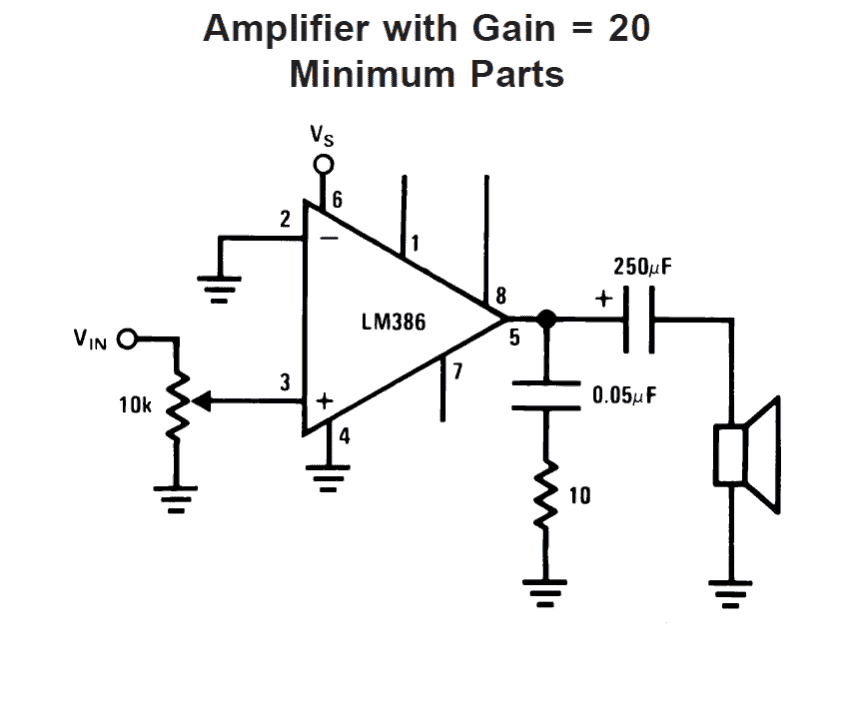
The input pin#2 goes to a 10K pot which becomes the volume control, one of its end terminals is picked for receiving the input signal while the other end is connected to ground, the center one goes to the hot end of the IC.
The speaker is connected to in #8 via a high value blocking capacitor, the resistor/capacitor arrangement connected across pin #5 and ground has been included for frequency compensation and to provide greater stability to the circuit.
Having Gain of 200
The next circuit shows a similar design as above, except that its pins 1 and 8 have been connected to a capacitor of 10uF, which as explained above helps to pull the gain of the amplifier to 200
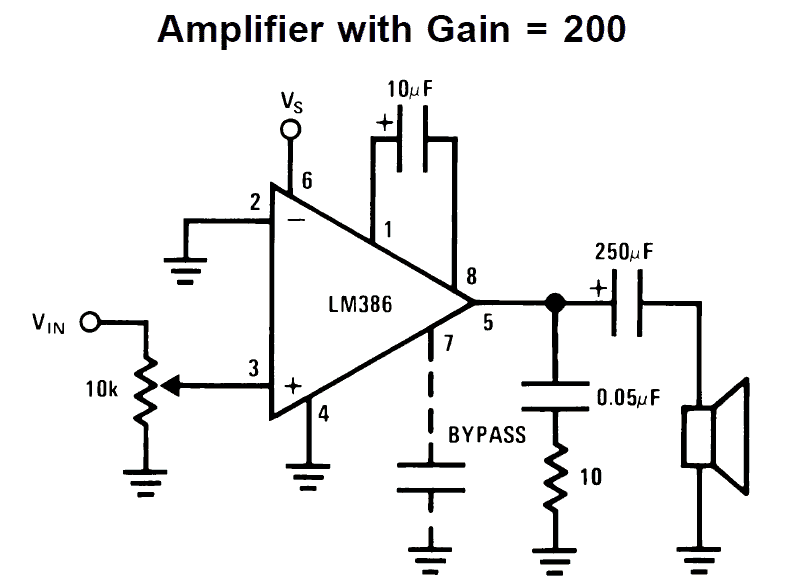
Detailed LM386 Circuit Diagram with Instructions
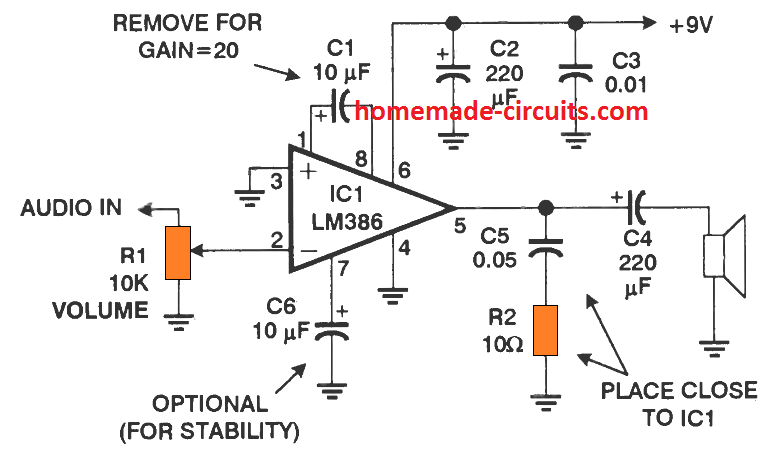
Application Circuits
From the above discussion we have learned that the LM386 is versatile little audio amplifier IC which can be applied in many different small audio related circuits quickly and with great efficiency.
The following are a few application circuits using IC LM386 which you an build and have a lot of fun.
MIC amplifier circuit using LM386 IC
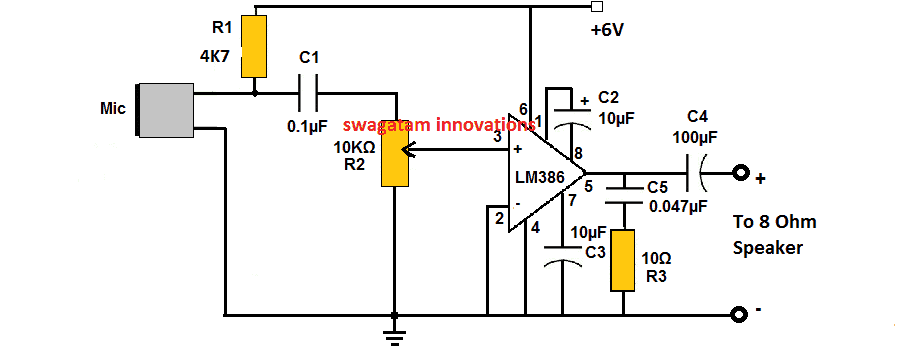
The following image shows how the above explained LM386 may be applied for achieving a simple yet powerful microphone amplifier circuit as shown below
LM386 Amplifier with Bass Boost
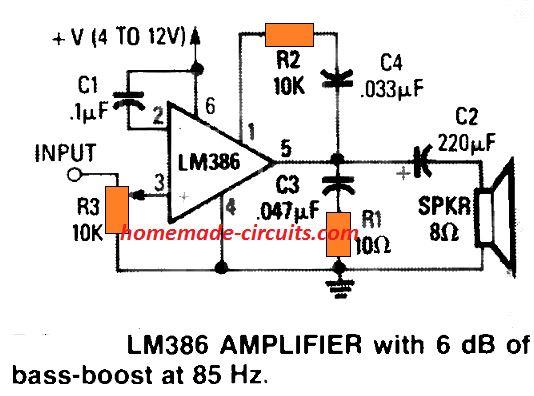
So far we know that attaching a 10-µF electrolytic across pins 1 and 8, it is possible to enhance the actual gain of the circuit to 200. This happens due to the capacitor appropriately shorting out the IC's in-built 1.35K resistor.
The figure above illustrates the way to shunt that resistor by implementing C4 -R2, to allow 6 -dB of bass boost at 85 Hz. This compensates the actual inability of the chip to produce suitable bass effect through typically used low-cost 8 ohm speakers.
AM Radio Circuit
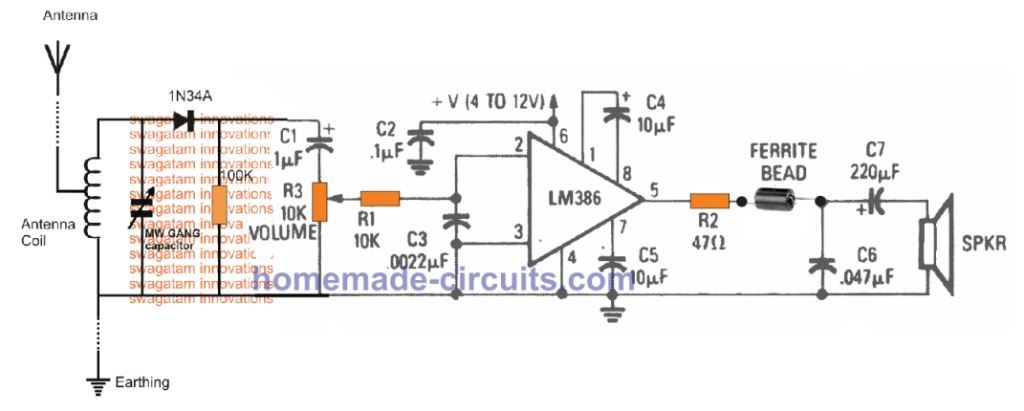
The figure above shows how the LM386 amplifier design could be customized like a compact amplifier for making a simple AM radio. Here, the detected AM transmission is supplied to the non-inverting input of the IC through volume control pot R3, and the resulting RF is de-coupled by way of R1, C3.
Any sort of left over RF disturbances are blocked from passing on to the loudspeaker through the indicated ferrite bead. In this LM386 AM radio design, the voltage gain of the IC is set at 200 through C4. You can also see that the circuit is supplied through supplemental power supply ripple rejection stage by configuring C5 between pin 7 and the negative line.
Infrared Decoder Amplifier
The next LM386 IC application circuit shows how the IC can be configured like an infrared receuver, amplifier and decoder.
Any infrared transmitter can be used to send the signal to this receiver. The LM386 receiver will receive the IR signals and convert them into audio signals through the connected loudspeaker.
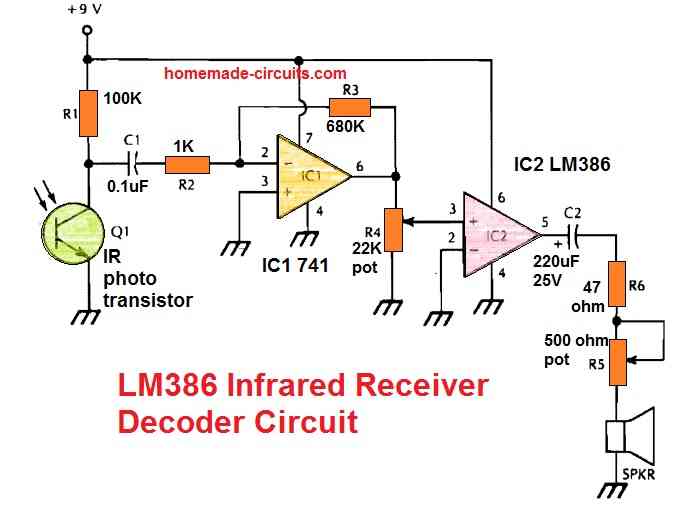
This receiver is intended to decode and demodulate all sorts of IR light beams that are amplitude-modulated (AM) and operate a loudspeaker. R5 is an optional volume control that may be removed. Q1 should be positioned properly and sheltered from stray incident light.
LM386 Signal Tracer Circuit
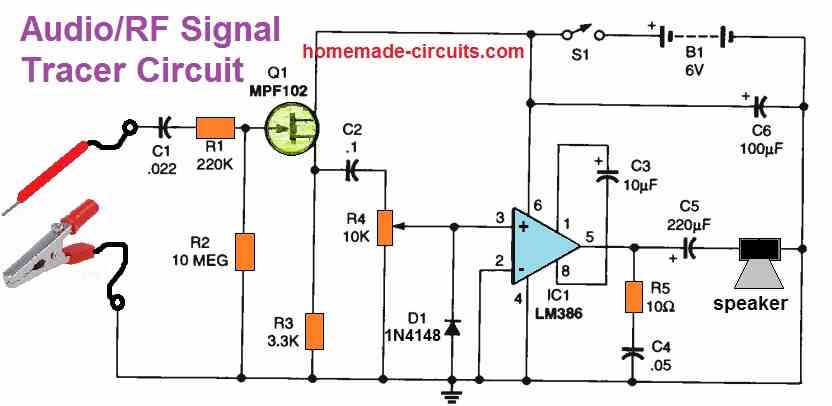
The AF/RF Signal tracer's schematic can be seen above. Q1 amplifies the input probe signal while R1 and R2 provide a bias for the FET.
R4 (the volume control) and D1 are capacitively linked to the amplified signal. Diode D1's function is to demodulate RF signals.
The signal is unaffected by D1 if you are working with audio signals. On the other hand, when dealing with RF signals, the diode behaves like a demodulator from a vintage crystal set.
The introduction of D1 increases the adaptability of the AF /RF Signal tracer. Signals that are phase-modulated or frequency-modulated (FM) or both can be detected; D1 serves as a slope detector. However, the audio quality will be substandard.
The last component of the circuit is a typical LM386 amplifier with an 8-ohm output and a gain of 200. The output of the IC LM386 may be connected to any compatible speaker or earphone.
Due to the coupling between S1 and R4, the AF/RF Signal tracer may be turned on and off by adjusting the volume, just like a battery-operated radio. A total of four AA batteries in a suitable holder serves as the power supply.
Simple Buzzer Circuit
An exact buzzer-like sound is produced by the circuit displayed below. Just a couple of ICs and a few other parts are needed to build this circuit.
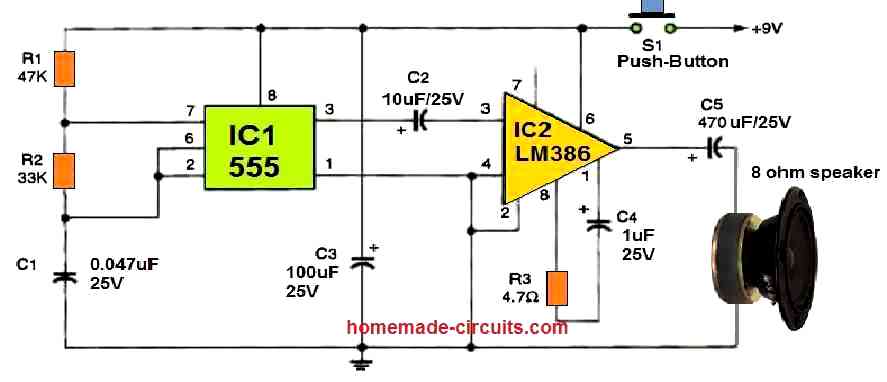
Through resistors R1 and R2, C1 begins to charge as soon as S1 is briefly pushed. In the end, it activates pin 2 of IC1's 555 oscillator/timer.
The IC subsequently starts discharging the capacitor by pushing pin 7 low via R2. As long as S1 remains pushed ON, this cycle happens repeatedly.
The pin#3 output of IC1 switches ON/OFF in response to the capacitor's charging and discharging, providing a sound frequency to IC2. IC2 is an LM386 low-voltage audio power amplifier that boosts the loudness of the tone frequency.
The sound frequency from IC1, which sounds like a genuine buzzer, is amplified by IC2 and reproduced through the speaker.
For a low-frequency buzzing sound, you can increase the value of C1 to 0.1 uF. For improved stability, you may also use a 47-F capacitor to bypass pin 7 of IC2 to ground.
Mini Megaphone Circuit
A min megaphone circuit can be built using single LM386 IC as shown in the following figure.
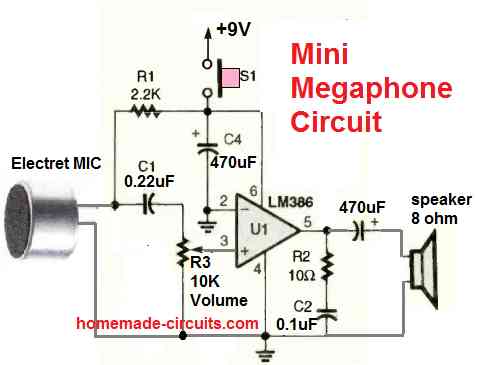
A megaphone is a hand held device with a MIC where the user can speak, so that the voice is amplified and can be listened over a larger distance.
The circuit utilizes a single LM386 IC, an electret MIC, and a small loudspeaker. It also includes a volume control pot for adjusting the loudness or the output amplification.
When the user speaks on the MIC, it is amplified through the loudspeaker allowing the user to address his or her speech loudly to the present audience.
